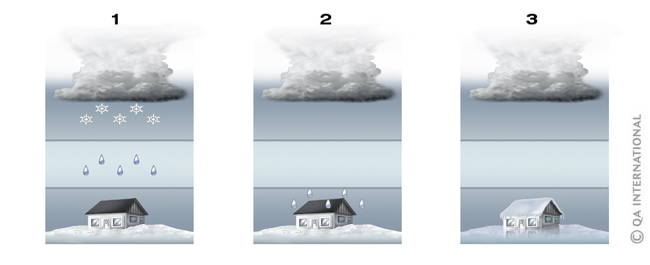
Winter storms: a world of snow and ice
Snowstorms
Billions of people around the world have never seen snow. Yet some cities in the Northern Hemisphere, like Montreal (Canada), Chicago (U.S.A.), and Sapporo (Japan), each receive millions of tons of snow every winter! When a lot of snow falls in a short period of time, it is called a snowstorm. Snowstorms close roads and airports, making it difficult or impossible to travel. If the snow is heavy enough, it may damage houses, electrical lines, and trees. For a big snowstorm to be produced, the right type of clouds must form. This requires temperatures close to freezing, combined with wind and a lot of water vapor in the air. If a snowstorm continues for three hours or longer with wind blowing at a speed of 35 mph (56 km/h) or more, and visibility is reduced to 1/4 mile (400 m) or less, the snowstorm is called a blizzard.
Snowed under!
The biggest amount of snow to ever fall in a single storm occurred at Mount Shasta Ski Bowl, California, in 1959. Between February 13 and 19, 15 ft 9 in. (4.80 m) of snow was dumped on the area. That’s almost the height of the average one-story house!
Snowflakes: icy jewels
There are no two snowflakes alike. Each one is made up of thousands of crystals of ice that have joined together in unique ways. Snowflakes come in two basic shapes: stars and needles. The temperature and amount of water vapor in the air decide what form these icy jewels will take. As different as they may seem, however, all snowflakes have something in common: six sides. This particular shape comes from the way the water freezes into ice crystals.

Ice storms
Under the magical spell of ice, the countryside sparkles like a fairytale scene frozen in time. In spite of its beauty, however, freezing rain is dangerous. It can make streets and sidewalks as slippery as skating rinks. When it lasts for several days, an ice storm becomes extremely destructive! It can snap electrical cables and topple the poles that hold them, leaving people without light and heat for their homes. In the forest, the heavy ice is capable of splitting apart thousands of trees. Wild animals might have trouble finding food because the plants they normally feed on during the wintertime may be trapped under a thick layer of ice.
The Great Ice Storm of '98
An ice storm hit eastern Canada, New England, and upstate New York in January 1998, when almost 4 in. (10 cm) of freezing rain fell in just six days! When electrical towers and poles collapsed, 4 million people were plunged into darkness and extreme cold. In some regions, the blackout lasted five weeks!
How does freezing rain form?
For freezing rain to form, all the right conditions must be present. The air close to the ground must be cold, below the freezing point (32°F/0°C). The layer of air close to the ground must be topped by warm air (above 32°F/0°C), and then topped by yet another layer of cold air. This is how freezing rain is formed:

- The snow that falls from the clouds meets warm air and is changed into rain.
- As these raindrops fall through the layer of colder air near the ground, they chill but do not freeze entirely, even if they are colder than the freezing point. At that moment, the raindrops are supercooled.
- When they finally hit the ground or come into contact with objects that are colder than 32°F (0°C), the supercooled raindrops freeze almost instantly and form a thin coating of ice.
Also see:
- The meteorology section of the Visual Dictionary
- Cyclones, monsters of the ocean
- Weather forecast: land meteorological station




